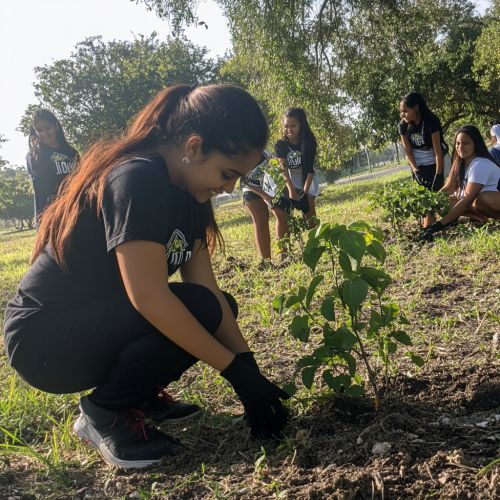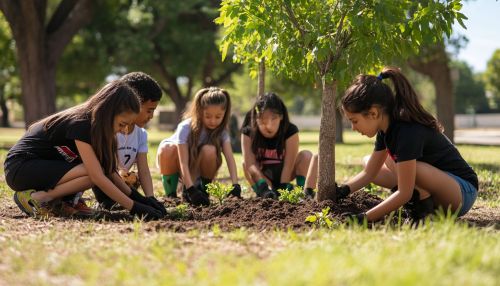Service Learning Academy: Difference between revisions
(Created page with "== Introduction == Service Learning Academy (SLA) is an educational framework that integrates community service with academic instruction, emphasizing critical, reflective thinking and personal and civic responsibility. This pedagogical approach is designed to enrich the learning experience by engaging students in activities that address human and community needs together with structured opportunities intentionally designed to promote student learning and development. S...") |
No edit summary |
||
| Line 63: | Line 63: | ||
Furthermore, there is a growing recognition of the need for inclusive and equitable service learning practices that address systemic inequalities and empower marginalized communities. This involves critically examining the power dynamics inherent in service relationships and striving for social justice outcomes. | Furthermore, there is a growing recognition of the need for inclusive and equitable service learning practices that address systemic inequalities and empower marginalized communities. This involves critically examining the power dynamics inherent in service relationships and striving for social justice outcomes. | ||
[[Image:Detail-99413.jpg|thumb|center|Students engaging in a community service project, planting trees in a park.|class=only_on_mobile]] | |||
[[Image:Detail-99414.jpg|thumb|center|Students engaging in a community service project, planting trees in a park.|class=only_on_desktop]] | |||
== See Also == | == See Also == | ||
Latest revision as of 22:28, 29 October 2024
Introduction
Service Learning Academy (SLA) is an educational framework that integrates community service with academic instruction, emphasizing critical, reflective thinking and personal and civic responsibility. This pedagogical approach is designed to enrich the learning experience by engaging students in activities that address human and community needs together with structured opportunities intentionally designed to promote student learning and development. Service learning is distinct from other forms of experiential education in that it is a reciprocal relationship between the student and the community, where both parties are both teachers and learners.
Historical Background
The concept of service learning has roots in the educational philosophies of John Dewey and other progressive educators who emphasized the importance of experiential learning. Dewey's work in the early 20th century laid the groundwork for what would become service learning by advocating for education that is directly connected to the experiences of students and the needs of society. The formalization of service learning as a distinct pedagogical approach began in the 1960s and 1970s, coinciding with the rise of civic engagement movements and the establishment of organizations such as the Peace Corps and AmeriCorps. These movements highlighted the potential of service as a means of education and personal development.
Theoretical Framework
Service learning is underpinned by several theoretical frameworks that guide its implementation and evaluation. One of the primary theories is Experiential Learning Theory, proposed by David Kolb, which posits that learning is a process whereby knowledge is created through the transformation of experience. This theory emphasizes the cyclical nature of learning, involving concrete experience, reflective observation, abstract conceptualization, and active experimentation.
Another significant framework is the Social Constructivist Theory, which suggests that learning is a social process and knowledge is constructed through interaction with others. This theory supports the collaborative nature of service learning, where students work with community members to solve real-world problems.
Components of Service Learning
Service learning programs typically consist of several key components:
- **Preparation**: This involves identifying community needs, setting learning objectives, and preparing students for their roles in the community. Preparation also includes training students in relevant skills and knowledge necessary for effective service.
- **Action**: The service activity itself, where students engage in meaningful tasks that address community needs. This can include a wide range of activities, such as tutoring, environmental conservation, or public health initiatives.
- **Reflection**: A critical component of service learning, reflection involves students analyzing their experiences, connecting them to academic content, and considering the broader implications of their service. Reflection can take many forms, including journals, discussions, and presentations.
- **Demonstration**: Students showcase their learning and the impact of their service through presentations, reports, or exhibitions. This component allows students to articulate their learning and the value of their contributions to the community.
Benefits of Service Learning
Service learning offers numerous benefits to students, educational institutions, and communities. For students, it enhances academic learning by providing practical applications of classroom knowledge, fosters personal growth and self-efficacy, and develops skills such as teamwork, communication, and problem-solving. It also promotes civic engagement and social responsibility by exposing students to diverse perspectives and societal issues.
For educational institutions, service learning strengthens community partnerships, enhances institutional reputation, and aligns with missions focused on civic engagement and social responsibility. Communities benefit from the resources and energy that students bring, as well as the opportunity to address local needs and build capacity.
Challenges and Criticisms
Despite its benefits, service learning faces several challenges and criticisms. One challenge is ensuring that the service activities are genuinely beneficial to the community and not just a means to an educational end. This requires careful planning and collaboration with community partners to identify meaningful projects.
Another criticism is the potential for reinforcing power imbalances between students and community members, particularly in underserved communities. To address this, service learning programs must emphasize reciprocity and mutual respect, ensuring that all parties are both teachers and learners.
Additionally, assessing the impact of service learning can be complex, as it involves measuring both academic outcomes and community impact. This requires robust evaluation methods and clear criteria for success.
Implementation Strategies
Successful implementation of service learning requires careful planning and collaboration among educators, students, and community partners. Key strategies include:
- **Building Strong Partnerships**: Establishing mutually beneficial relationships with community organizations is crucial for identifying meaningful service opportunities and ensuring the sustainability of projects.
- **Integrating with Curriculum**: Service learning should be closely aligned with academic content and learning objectives to maximize its educational value. This involves designing projects that complement and enhance classroom instruction.
- **Providing Support and Resources**: Institutions should provide adequate support and resources for faculty and students, including training, funding, and logistical assistance.
- **Fostering Reflection and Assessment**: Encouraging ongoing reflection and assessment helps students connect their experiences to academic content and personal growth. This can be facilitated through structured reflection activities and regular feedback.
Case Studies
Several institutions have successfully implemented service learning programs, showcasing diverse approaches and outcomes. For example, Stanford University's Haas Center for Public Service offers a range of service learning opportunities that integrate with various academic disciplines. Similarly, Tulane University has made service learning a graduation requirement, embedding it within the core curriculum to promote civic engagement and social responsibility.
Future Directions
As service learning continues to evolve, several trends and opportunities are emerging. The increasing emphasis on Global Citizenship Education highlights the potential for international service learning experiences, where students engage with communities abroad to address global challenges.
Technology is also playing a growing role in service learning, with digital platforms facilitating virtual service projects and expanding the reach of programs. This is particularly relevant in the context of Online Learning environments, where traditional in-person service activities may be limited.
Furthermore, there is a growing recognition of the need for inclusive and equitable service learning practices that address systemic inequalities and empower marginalized communities. This involves critically examining the power dynamics inherent in service relationships and striving for social justice outcomes.


